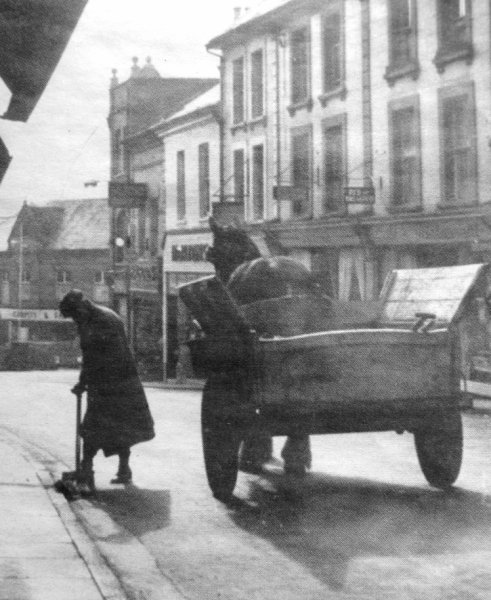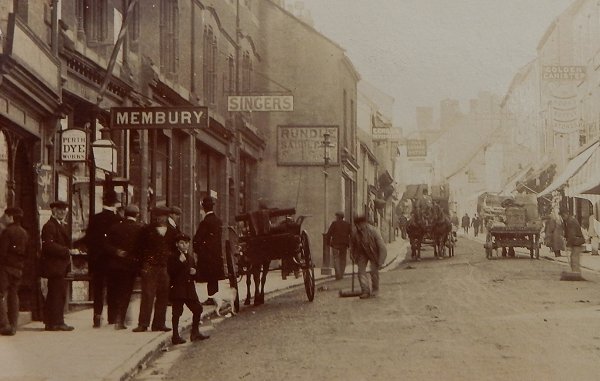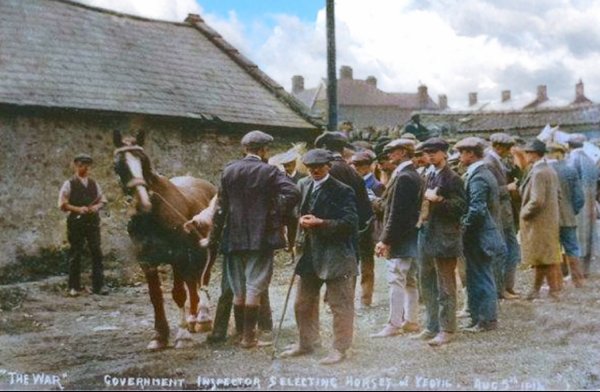Corporation Horses
Corporation horses
Literally the 'workhorse' of the pre-lorry era
Until the early twentieth century the horse was a part of everyday life - just look at some of the early photographs on this website of, for instance, Middle Street or High Street and a horse is almost certain to be seen somewhere, usually pulling a cart or a trap - even the early omnibuses that ran between the hotels and the railway stations were pulled by horses.
When I worked in the Architect's Department of the Council in the 1970s I remember in the Chief Technical Officer's bookcase was a Register of Corporation Horses that recorded all the details of the Council's horses. This register is now kept at the Community Heritage Access Centre.
The register covers 38 horses used by the Council between 1905 and 1954, with each horse having its own double-spread page detailing its type (such as Chestnut Cob, Dark Bay Mare, Red Roan Horse or Bay Cart Gelding), age, sometimes its height in hands, when it was purchased, who it was purchased from and the price paid. This is followed by the horses medical history during its employment, when it was laid off, rested, visited by a vet, etc. The horses are only referred to by number in the register although I'm sure they all had names.
Injuries and illnesses were recorded along with remedies and the length of time each horse was given to recover. One frequent apparent medical condition suffered by several horses was called 'nightfall' but despite extensive searching I am unable to determine exactly what this condition is.
Most of the horses were around 5 or 6 years old when bought and the average number of years they worked was around 9 years with nearly half working over 10 years and three worked for 16 years. What happened at the end of each horse's employment at the Corporation is not always clear but 10 were sold, 14 had to be destroyed, 4 died 'in service' and two were killed in accidents.
In 1912 a bay horse "Died suddenly working on Housing Scheme" and another horse was stopped from working by police in 1914. This horse was sold two weeks later. In 1919 a light bay horse was involved in an "Accident in Hendford. Shaft of trap driven by Mr Jolliffe, Beer Hackett, run into right breast" and the horse died from its injuries two days later. A cob pony was also killed in an accident in 1938, at Ilchester Road.
Another accident, but with a happier outcome, occurred in August 1917 and was recorded in the register - "Happened accident in Princes Street, by being run into from behind by run away horse belonging to Mrs Chainey, Cromwell Road. Wheel of wagon attached to run away horse locked with wheel from cart forcing the mare onto the footpath when she was thrown onto her haunches and with her fore feet broke the plate glass window of Mr Coles shop." The horse recovered and was back to work within a month, continuing until 1924.
As a sidenote - government inspectors visited Yeovil to requisition horses for war service during the Great War but it appears from the Register of Corporation Horses that none of the Corporation's horses were taken. Even so, around six million horses served in the Great War but because Britain's horse population at the time was between 20,000 and 25,000, horses were imported from Australia, Canada, the USA and Argentina for war service.
By 1911 the Corporation employed 11 horses and until 1926 about 12 horses were employed at any one time. From then until the outbreak of the Second World War the average dropped to about 8 at any one time. The number of horses dwindled until by 1944 only two horses were employed. Two new horses were purchased in 1945 and one in 1946. From 1950 until 1954 this last horse, a bay Welsh mare, was the only one employed by the Corporation. It was sold to Councillor D Vincent and finally left the Corporation's service on 19 May 1954, thus ending the era of the Corporation's horses.
|
From the
Borough
Council's
Markets
& Tolls
Committee ...
25.
Reference
item 2
of the
last
minutes,
the Town
Clerk
reported
that the
Council
at their
meeting
on 11
October
instructed
that
Horse No
2, which
is
suffering
from an
incurable
disease,
should
be
slaughtered
in the
Town
Yard and
sold.
The
Borough
Surveyor
stated
he had
received
several
offers
for the
purchase
of the
animal,
the
highest
of which
was from
Mr H
Wright,
Mudford
Road,
who
offered
£25 to
slaughter
for
human
consumption.
Councillor
Shorney
stated
that Mr
Wright
had
informed
him that
his
offer of
£25 was
subject
to the
horse
being
conveyed
some
considerable
distance
from the
town,
where it
would be
slaughtered
and sold
for
human
consumption,
but if
it was a
condition
of the
sale
that the
horse
must be
slaughtered
in the
Depot,
then he
was
unable
to offer
more
than
£15.
Many thanks to Vivien Cornelius for informing me of the above |
Gallery

Courtesy of the
Western Gazette
This photograph, showing a Council street cleaner with his horse and cart, probably dates to around 1930 and was taken from outside Neal & Williams' premises in Middle Street and looks towards the Triangle.

A photograph of around 1910 looking along Middle Street to the Borough, with two council road sweepers (one at centre, one at extreme right) with their horse and cart left of centre.

Government inspectors visited Yeovil to requisition horses for war service during the Great War but it appears from the Register of Corporation Horses that none of the Corporation's horses were taken.
Around six million horses served in the Great War, but because Britain's horse population was between 20,000 and 25,000, thousands of horses were imported from Australia, Canada, the USA and Argentina.